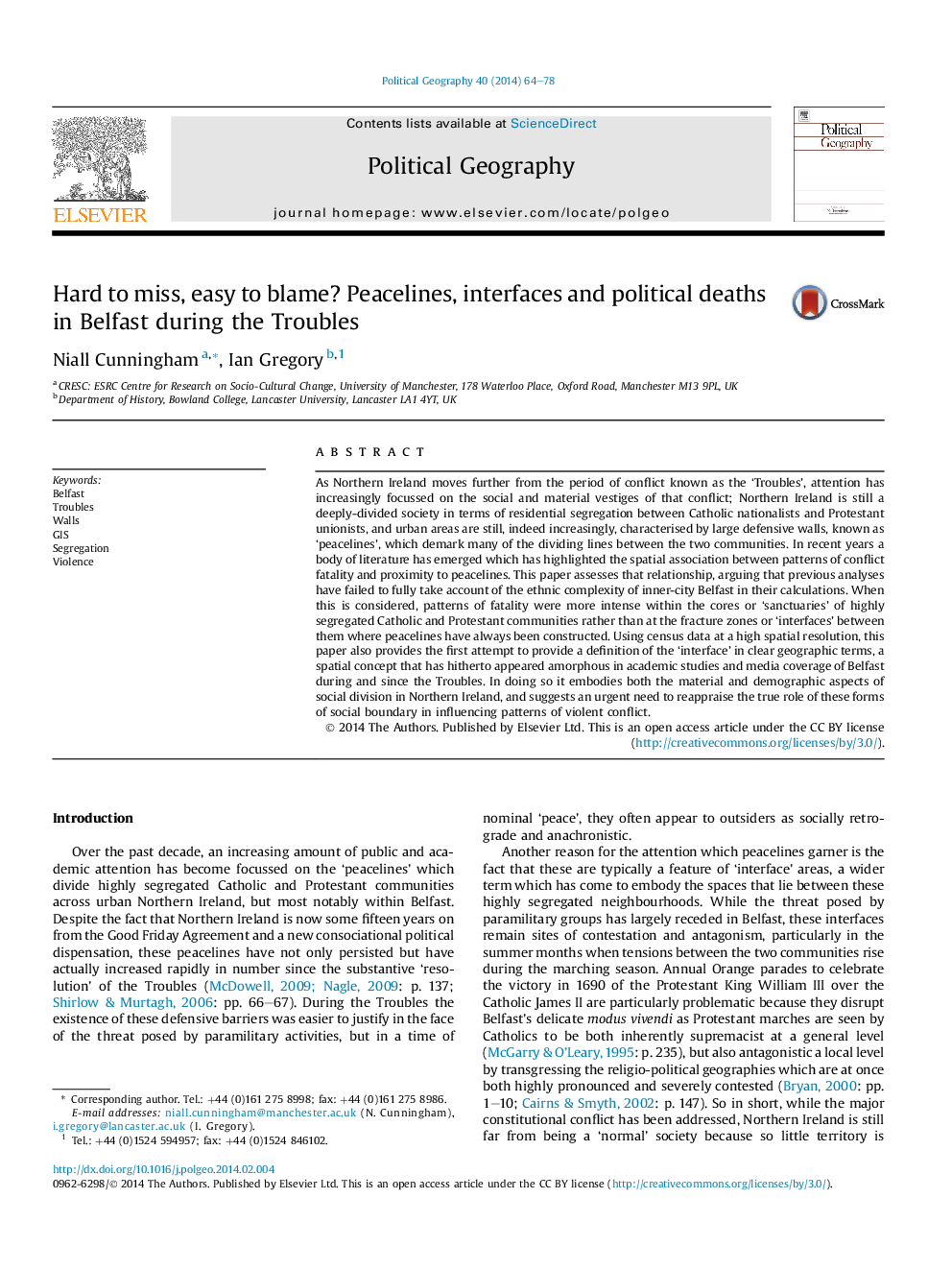| کد مقاله | کد نشریه | سال انتشار | مقاله انگلیسی | نسخه تمام متن |
|---|---|---|---|---|
| 7493534 | 1485592 | 2014 | 15 صفحه PDF | دانلود رایگان |
عنوان انگلیسی مقاله ISI
Hard to miss, easy to blame? Peacelines, interfaces and political deaths in Belfast during the Troubles
ترجمه فارسی عنوان
سخت به دست، آسان به سرزنش؟ صلح آمیز، رابط ها و مرگ های سیاسی در بلفاست در طول مشکلات
دانلود مقاله + سفارش ترجمه
دانلود مقاله ISI انگلیسی
رایگان برای ایرانیان
کلمات کلیدی
ترجمه چکیده
همانطور که ایرلند شمالی بیشتر از دوران جنگ نامیده می شود، به عنوان «مشکلات»، توجه به طور فزاینده ای روی تأثیرات اجتماعی و مادی این نزاع متمرکز شده است؛ ایرلند شمالی همچنان یک جامعه عمیقا تقسیم شده از لحاظ جدائی روستایی بین ملی گرایان کاتولیک و اعضای اتحادیه های پروتستان است و مناطق شهری هنوز هم در واقع به طور فزاینده ای با دیوارهای دفاعی بزرگ شناخته می شوند که "صلح طلبان" نامیده می شوند که بسیاری از خطوط تقسیم بین دو اجتماع در سال های اخیر مجموعه ای از ادبیات مطرح شده است که نشان دهنده ارتباط فضایی بین الگوهای مرگ و میر درگیری و نزدیکی به صلح پایه ها است. این مقاله این رابطه را ارزیابی می کند و استدلال می کند که تجزیه و تحلیل های قبلی نتوانسته اند به طور کامل در محاسبات خود به پیچیدگی قومی شهر بلفاست توجه نشان دهند. هنگامی که این در نظر گرفته می شود، الگوهای مرگ و میر در هسته ها و یا "حرمسرا" از جوامع بسیار کاتولیکی و پروتستان ها شدیدتر است نه در ناحیه شکستگی و یا "رابط ها" بین آنها که در آن همیشه صلح پایه ساخته شده است. با استفاده از داده های سرشماری با وضوح بالا فضایی، این مقاله همچنین اولین تلاش برای ارائه تعریفی از رابط کاربری در شرایط جغرافیایی روشن است، یک مفهوم فضایی که تاکنون در مطالعات علمی و پوشش رسانه ای بلفاست در طول و از زمان مشکل در انجام این کار، جنبه های مادی و جمعیت شناختی تقسیم اجتماعی در ایرلند شمالی را به تصویر می کشد، و پیشنهاد می کند که نیازمندی های فوری برای بررسی نقش واقعی این اشکال مرز اجتماعی در تأثیر الگوهای درگیری خشونت آمیز وجود دارد.
موضوعات مرتبط
علوم انسانی و اجتماعی
علوم انسانی و هنر
تاریخ
چکیده انگلیسی
As Northern Ireland moves further from the period of conflict known as the 'Troubles', attention has increasingly focussed on the social and material vestiges of that conflict; Northern Ireland is still a deeply-divided society in terms of residential segregation between Catholic nationalists and Protestant unionists, and urban areas are still, indeed increasingly, characterised by large defensive walls, known as 'peacelines', which demark many of the dividing lines between the two communities. In recent years a body of literature has emerged which has highlighted the spatial association between patterns of conflict fatality and proximity to peacelines. This paper assesses that relationship, arguing that previous analyses have failed to fully take account of the ethnic complexity of inner-city Belfast in their calculations. When this is considered, patterns of fatality were more intense within the cores or 'sanctuaries' of highly segregated Catholic and Protestant communities rather than at the fracture zones or 'interfaces' between them where peacelines have always been constructed. Using census data at a high spatial resolution, this paper also provides the first attempt to provide a definition of the 'interface' in clear geographic terms, a spatial concept that has hitherto appeared amorphous in academic studies and media coverage of Belfast during and since the Troubles. In doing so it embodies both the material and demographic aspects of social division in Northern Ireland, and suggests an urgent need to reappraise the true role of these forms of social boundary in influencing patterns of violent conflict.
ناشر
Database: Elsevier - ScienceDirect (ساینس دایرکت)
Journal: Political Geography - Volume 40, May 2014, Pages 64-78
Journal: Political Geography - Volume 40, May 2014, Pages 64-78
نویسندگان
Niall Cunningham, Ian Gregory,
